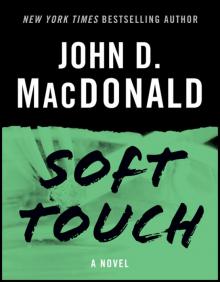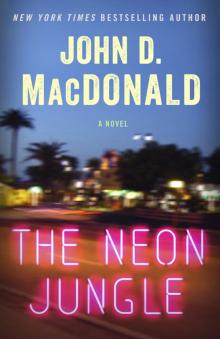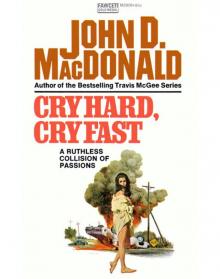- Home
- John D. MacDonald
The Girl in the Plain Brown Wrapper
The Girl in the Plain Brown Wrapper Read online
Praise for
John D. MacDonald
“My favorite novelist of all time.”
—DEAN KOONTZ
“For my money, John D. MacDonald’s Travis McGee is one of the great characters in contemporary American fiction—not crime fiction; fiction, period—and millions of readers surely agree.”
—The Washington Post
“MacDonald isn’t simply popular; he’s also good.”
—ROGER EBERT
“MacDonald’s books are narcotic and, once hooked, a reader can’t kick the habit until the supply runs out.”
—Chicago Tribune Book World
“Travis McGee is one of the most enduring and unusual heroes in detective fiction.”
—The Baltimore Sun
“[John D. MacDonald] remains one of my idols.”
—DONALD WESTLAKE
“A dominant influence on writers crafting the continuing series character.”
—SUE GRAFTON
“The Dickens of mid-century America—popular, prolific and … conscience-ridden about his environment.… A thoroughly American author.”
—The Boston Globe
“It will be for his crisply written, smoothly plotted mysteries that MacDonald will be remembered.”
—USA Today
“MacDonald had the marvelous ability to create attention-getting characters who doubled as social critics. In MacDonald novels, it is the rule rather than the exception to find, in the midst of violence and mayhem, a sentence, a paragraph, or several pages of rumination on love, morality, religion, architecture, politics, business, the general state of the world or of Florida.”
—Sarasota Herald-Tribune
Praise for the Travis McGee series
“There’s only one thing as good as reading a John D. MacDonald novel: reading it again. A writer way ahead of his time, his Travis McGee books are as entertaining, insightful, and suspenseful today as the moment I first read them. He is the all-time master of the American mystery novel.”
—JOHN SAUL
“One of the great sagas in American fiction.”
—ROBERT B. PARKER
“In McGee mysteries and other novels as well, MacDonald’s voice was one of a social historian.”
—Los Angeles Times
The Girl in the Plain Brown Wrapper is a work of fiction. Names, characters, places, and incidents are products of the author’s imagination or are used fictitiously. Any resemblance to actual events, locales, or persons, living or dead, is entirely coincidental.
2013 Random House Trade Paperback Edition
Copyright © 1964 by John D. MacDonald Publishing, Inc.
Copyright renewed 1992 by Maynard MacDonald
Introduction copyright © 2013 by Lee Child
Excerpt from Dress Her in Indigo by John D. MacDonald copyright © 1969 by John D. MacDonald Publishing, Inc. Copyright renewed 1997 by Maynard MacDonald.
All rights reserved.
Published in the United States by Random House Trade Paperbacks, an imprint of The Random House Publishing Group, a division of Random House, Inc., New York.
RANDOM HOUSE TRADE PAPERBACKS and colophon are trademarks of Random House, Inc.
Originally published in mass market in the United States by Fawcett, a division of Random House, Inc., New York in 1964.
eISBN: 978-0-307-82671-8
www.atrandom.com
Cover design: Joe Montgomery
Cover photograph: © znisian Hughes/Gallery Stock
v3.1
Contents
Cover
Title Page
Copyright
Introduction
Chapter One
Chapter Two
Chapter Three
Chapter Four
Chapter Five
Chapter Six
Chapter Seven
Chapter Eight
Chapter Nine
Chapter Ten
Chapter Eleven
Chapter Twelve
Chapter Thirteen
Chapter Fourteen
Chapter Fifteen
Chapter Sixteen
Chapter Seventeen
Chapter Eighteen
Chapter Nineteen
Chapter Twenty
Chapter Twenty-one
Excerpt from Dress Her in Indigo
Other Books by This Author
About the Author
Introduction
Lee Child
Suspense fiction trades on surprising and unexpected twists. Like this one: A boy named John Dann MacDonald was born in 1916 in Sharon, Pennsylvania, into the kind of quiet and comfortable middle-class prosperity that became common in America forty or fifty years later but which was still relatively rare early in the century. Sharon was a satellite town near Pittsburgh, dominated by precision metalworking, and John’s father was a mild-mannered and upstanding citizen with secure and prestigious salaried employment as a senior financial executive with a local manufacturer. Young John was called Jack as a child, and wore sailor suits, and grew up in a substantial suburban house on a tree-lined block. He read books, played with his dog, and teased his little sister and his cousin. When he was eighteen, his father funded a long European grand tour for him, advising him by letter “to make the best of it … to eat and function regularly … to be sure and attend a religious service at least once on each Sunday … to keep a record of your expenditures as a training for your college days.”
Safely returned, young Jack went on to two decent East Coast schools, and married a fellow student, and went to Harvard for an MBA, and volunteered for the army in 1940, and finished World War II as a lieutenant colonel, after thoroughly satisfactory service as a serious, earnest, bespectacled, rear-echelon staff officer.
So what does such a fellow do next? Does he join General Motors? IBM? Work for the Pentagon?
In John D. MacDonald’s case, he becomes an impoverished writer of pulp fiction.
During his first four postwar months, he lost twenty pounds by sitting at a table and hammering out 800,000 unsold words. Then in his fifth month he sold a story for twenty-five bucks. Then another for forty bucks, and eventually more than five hundred. Sometimes entire issues of pulp magazines were all his own work, disguised under dozens of different pen names. Then in 1950 he watched the contemporary boom in paperback novels and jumped in with his first full-length work, which was followed by sixty-six more, including some really seminal crime fiction and one of history’s greatest suspense series.
Why? Why did a middle-class Harvard MBA with extensive corporate connections and a gold-plated recommendation from the army turn his back on everything apparently predestined, to sit at a battered table and type, with an anxious wife at his side? No one knows. He never explained. It’s a mystery.
But we can speculate. Perhaps he never wanted a quiet and comfortable middle-class life. Perhaps, after finding himself amid the chaos of war, he felt able to liberate himself from the crushing filial expectations he had previously followed so obediently. As an eighteen-year-old, it’s hard to say no to the father who just paid for a trip to Europe. Eleven years later, as a lieutenant colonel, it’s easier.
And we know from what he wrote that he felt he had something to say to the world. His early stuff was whatever put food on that battered table—detective stories, westerns, adventure stories, sports stories, and even some science fiction—but soon enough his long-form fiction began to develop some enduring and intertwined themes. From A Deadly Shade of Gold, a Travis McGee title: “The only thing in the world worth a damn is the strange, touching, pathetic, awesome nobility of the individual human spirit.” From the stand-alone thriller Wh
ere Is Janice Gantry?: “Somebody has to be tireless, or the fast-buck operators would asphalt the entire coast, fill every bay, and slay every living thing incapable of carrying a wallet.”
These two angles show up everywhere in his novels: the need to—maybe reluctantly, possibly even grumpily—stand up and be counted on behalf of the weak, helpless, and downtrodden, which included people, animals, and what we now call the environment—which was in itself a very early and very prescient concern: Janice Gantry, for instance, predated Rachel Carson’s groundbreaking Silent Spring by a whole year.
But the good knight’s armor was always tarnished and rusted. The fight was never easy and, one feels, never actually winnable. But it had to be waged. This strange, weary blend of nobility and cynicism is MacDonald’s signature emotion. Where did it come from? Not, presumably, the leafy block where he was raised in quiet and comfort. The war must have changed him, like it changed a generation and the world.
Probably the best of his nonseries novels is The Executioners, which became Cape Fear as a movie (twice). It’s an acute psychological study of base instinct, terror, mistakes, and raw emotion. It’s about a man—possibly a man like MacDonald’s father, or like MacDonald himself—who moves out of his quiet and comfort into more primeval terrain. And those twin poles are the theme of the sensationally good Travis McGee series, which is a canon equaled for enduring quality and maturity by very little else. McGee is a quiet man, internally bewildered by and raging at what passes for modern progress, externally happy merely to be varnishing the decks of his houseboat and polishing its brass, but always ready to saddle up and ride off in the service of those who need and deserve his help. Again, not the product of the privileged youth enjoyed by the salaried executive’s son.
So where did McGee and MacDonald’s other heroes come from? Why Florida? Why the jaundiced concerns? We will never know. But maybe we can work it out, by mining the millions of words written with such haste and urgency and passion between 1945 and 1986.
LEE CHILD
New York
2012
One
It is one of the sorry human habits to play the game of: What was I doing when it happened?
After I heard that Helena Pearson had died on Thursday, the third day of October, I had no trouble reconstructing the immediate past.
That Thursday had been the fourth and final day of a legitimate little job of marine salvage. Meyer made a lot of small jokes about Travis McGee, salvage expert, actually doing some straight-arrow salvage. He kept saying it almost made my cover story believable. But he did not say such things for any ears but mine own.
Actually it was not my ball game. Meyer gets himself involved in strange little projects. Somewhere, somehow he had gotten interested in the ideas of a refugee Cuban chemist named Joe Palacio. So he had talked a mutual friend of ours, Bobby Guthrie, a damned good man with pumps and pressures and hydraulics, into listening to Joe’s ideas and going to Joe’s rooming house in Miami where Joe had set up a miniaturized demonstration in an old bathtub he had scrounged somewhere.
When Bobby got high enough on the idea to quit his regular job, Meyer put in the money and they formed a little partnership and named it Floatation Associates.
Then Meyer, in one of his mother hen moods, sweet-talked me into donating my services, plus my houseboat, The Busted Flush, plus my swift little Muñequita boat to the first actual salvage operation. So I had to take the Flush down to a Miami yard where they winched aboard a big ugly diesel pump with special attachments rigged by Bobby Guthrie, some great lengths of what appeared to be reinforced fire hose, and several fifty-five-gallon drums of special gunk mixed up by Joe Palacio, plus scuba tanks, air compressor, tools, torches, and so on. Once I had topped off the water and fuel tanks and laid aboard the provisions and booze, the old Flush was as low in the water as I cared to see her. Even with all her beam, and that big old barge-type hull, she had to react to what Bobby estimated as seven thousand pounds of extra cargo. She seemed a little discouraged about it.
“If she founders,” Meyer said pleasantly, “we’ll see if we can raise her with Palacio’s magic gunk.”
So we took off down Biscayne Bay with the Muñequita in tow, heading for the lower Keys. We got an early start and kept waddling along, and by last light we were far enough down Big Spanish Channel to edge cautiously over into the shallows off Annette Key, in the lee of a southwest breeze, and drop a couple of hooks.
The immediate forecast was good, but there was an area of suspicion over near the Leeward Islands, and there was an official half month of the whirly-girl season left. Also the girls are known to come screaming up through hurricane alley after the season is over.
Later I learned that Helena Pearson had written the letter to me that same Saturday, September 28th, the day after she guessed she wasn’t going to make it, the letter the attorney mailed, still sealed, with his cover letter. And with the certified check.
That evening at anchor aboard The Busted Flush the three Floatation associates were edgy. For Meyer it was simple empathy. He knew the risks they were taking. Joe Palacio had a chance to make a new career in his adopted land. Bobby Guthrie had a wife and five kids to worry about. The three of them had periods of contagious enthusiasm, and then they would get the doubts and the glooms and the hollow laughter. If it worked on a very small scale in the scavenged bathtub, that didn’t mean it was going to work out in Hawk Channel, in the Straits of Florida, in seventy-five feet of ocean.
In the morning we went south down Big Spanish, past No Name Key, and under the fixed bridge between Bahia Honda Key and Spanish Harbor Key. Then the overladen Flush was out in the deeps, and we had a nine-mile run at about 220 degrees to lonely little Looe Key, across a slow heave of greasy swell. Soon I was able to pick up the red marker on Looe with the glasses. On the way, while on automatic pilot, I had figured out the quickest and best way to run if things blew up too suddenly. I would pour on all the coal and run just a shade east of magnetic north, perhaps 8 degrees, and if I could manage to make eight knots, I could tuck the Flush into Newfound Harbor Channel in maybe forty minutes, and find a protected pocket depending on the wind, maybe in Coupon Bight or close offshore by Little Torch Key.
Bobby Guthrie had the coordinates on the sunken pleasure boat. She lay a half mile southwest of Looe Key. She’d been down there for two months. She was the ’Bama Gal, owned by a Tampa hotelman, about ninety thousand dollars’ worth of cabin cruiser, only six months old. Forty-six feet, fiberglass hull, twin diesels. The hotelman and his wife and another couple had been out fishing and the hotelman had keeled over with a heart attack while fighting a billfish. Nobody else aboard knew how to run the ship-to-shore radio. They barely knew how to run the boat. There was a tug with a tow of three barges about a half mile farther out, so they figured that the tug would have a radio they could use to call a Coast Guard helicopter and get the man to a hospital. The guest ran the boat over toward the tug and cut the engines and they all started waving their arms. Maybe they thought that tugs and barges have some kind of braking system. The tug captain tried evasive tactics, but mass and momentum were too much. The forward port corner of the lead barge put a big ugly hole in the cruiser, but the crew launched a skiff and got the people off in good order before she went down. By the time the Coast Guard arrived, the owner was as dead as the other fish they had caught, which had gone down with the cruiser.
The insurance company had paid off on the cruiser, and Meyer had gotten a release from them, so any recovery was going to be profit—if we could bring it up, tow it in, and find something worth money.
So on that Sunday I worked the Flush into the most protected water that Looe provides. It is shaped like a backward “J” that has fallen onto its back, and I put the hooks out in shoal water, as close as I could get without risking being hard aground at low tide. We took the Muñequita out and located the ’Bama Gal after about forty minutes of skin diving and looking. We made a bright red buoy fast to her, and
then I ran the Muñequita up-current, put the anchor down in about seventy feet, and let her come back to the buoy before snubbing her down, almost at the end of my four hundred feet of anchor line. Not enough scope to be sure of holding.
We had just the two sets of tanks aboard the Muñequita, so I went down with Joe Palacio to get a good look at what condition she was in. She lay on a little slope, bow higher than the stern, and she was on about a fifteen-degree list to port, making the hole in the starboard side, a little aft of amidships, easy to see. She was picking up new grass and weed and green slime, but it wasn’t too bad yet. We had expected to find her picked clean of everything the skin-diver kids could lift, but by some freak of chance they hadn’t found her. The big rods with their Finor reels were still in the rod holders. Binoculars, booze, cameras, tackle boxes, rifle, sunglasses—all the toys and gear and gadgets that people take to sea were either stowed or lay on the cockpit, cabin, or fly-bridge decking. While Joe busied himself with studying the hatches and the interior layout, and measuring interior spaces, I kept assembling bundles of goodies and, with a couple of pulls on the dangling line, sending them up into the sunlight.
When we went up, I found that all the stuff had looked better down in the depths, green and shadowy, than up on the deck of my runabout, all sodden, leaking, and corroded.
Monday we took the Flush out and anchored her over the wreck and worked all day, in shifts, beefing up those places where Palacio thought the floatation might come busting out, and also cutting through some interior bulkheads to make a free flow of water through all the belowdecks areas, and fastening some plywood against the inside of the hull where the big hole was. Whenever we came across anything we could tie a line to and lift to the surface, we did so.
The weather held on Tuesday and by noon Joe was satisfied that we were ready to try. We took the reinforced hose down and clamped it securely in place, leading it through the hole we’d cut into the damaged side above the waterline. We had made no attempt to make her watertight. That was the last thing Palacio wanted.

 More Good Old Stuff
More Good Old Stuff The Long Lavender Look
The Long Lavender Look April Evil
April Evil I Could Go on Singing
I Could Go on Singing Death Quotient and Other Stories
Death Quotient and Other Stories Murder in the Wind
Murder in the Wind The Quick Red Fox
The Quick Red Fox The Scarlet Ruse
The Scarlet Ruse Darker Than Amber
Darker Than Amber One Monday We Killed Them All
One Monday We Killed Them All A Deadly Shade of Gold
A Deadly Shade of Gold The Girl, the Gold Watch and Everything
The Girl, the Gold Watch and Everything The Damned
The Damned The Brass Cupcake
The Brass Cupcake Cinnamon Skin
Cinnamon Skin Bright Orange for the Shroud
Bright Orange for the Shroud The Empty Trap
The Empty Trap Where Is Janice Gantry?
Where Is Janice Gantry? Soft Touch
Soft Touch Condominium
Condominium The Neon Jungle
The Neon Jungle Girl In The Plain Brown Wrapper
Girl In The Plain Brown Wrapper All These Condemned
All These Condemned Area of Suspicion
Area of Suspicion The Crossroads
The Crossroads The Good Old Stuff
The Good Old Stuff The Girl in the Plain Brown Wrapper
The Girl in the Plain Brown Wrapper The Beach Girls
The Beach Girls A Purple Place For Dying
A Purple Place For Dying The Turquoise Lament
The Turquoise Lament The Empty Copper Sea
The Empty Copper Sea You Live Once
You Live Once The House Guests
The House Guests A Bullet for Cinderella
A Bullet for Cinderella A Man of Affairs
A Man of Affairs A Key to the Suite
A Key to the Suite Please Write for Details
Please Write for Details Free Fall in Crimson
Free Fall in Crimson The Dreadful Lemon Sky
The Dreadful Lemon Sky Judge Me Not
Judge Me Not The Price of Murder
The Price of Murder On the Run
On the Run The Deep Blue Good-Bye
The Deep Blue Good-Bye The Only Girl in the Game
The Only Girl in the Game The Green Ripper
The Green Ripper Kitten on a Trampoline
Kitten on a Trampoline Cry Hard, Cry Fast
Cry Hard, Cry Fast A Flash of Green
A Flash of Green The End of the Night
The End of the Night Contrary Pleasure
Contrary Pleasure Cape Fear
Cape Fear The Lonely Silver Rain
The Lonely Silver Rain Slam the Big Door
Slam the Big Door The Last One Left
The Last One Left The Drowner
The Drowner Death Trap
Death Trap Wine of the Dreamers: A Novel
Wine of the Dreamers: A Novel A Tan and Sandy Silence
A Tan and Sandy Silence One Fearful Yellow Eye
One Fearful Yellow Eye Border Town Girl
Border Town Girl Weep for Me
Weep for Me Dress Her in Indigo
Dress Her in Indigo Deadly Welcome
Deadly Welcome Cancel All Our Vows
Cancel All Our Vows Murder for the Bride
Murder for the Bride End of the Tiger
End of the Tiger